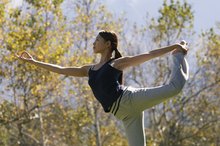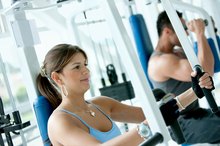Posture & Heart Rate
Posture is the position in which you hold your body upright against gravity while standing, sitting or lying down, according to the Cleveland Clinic. Heart rate is the measurement of the number of times your heart contracts or beats in one minute. Your posture has an effect on your heart rate. In terms of a lying, sitting or standing body position, a standing position will produce the highest heart rate while a lying position will result in the lowest heart rate. In addition, chronic postural diseases and poor habits can also increase your heart rate.
Measuring Heart Rate
You can measure your heart rate by counting your pulse rate for one minute. The best places on your body to measure your pulse rate are either the carotid or radial arteries. To count your pulse rate using the carotid artery, place two fingers of one hand lightly on one side of your neck adjacent to the larynx. To count your pulse rate using your radial artery, place two fingers on your wrist on the inside of your arm.
Postural Position and Heart Rate
Why Does Laying on My Side Lower My Blood Pressure?
Learn More
You can perform a simple experiment to measure the effect that posture has on your heart rate. Lie down for three minutes, then measure your pulse rate. Sit for three minutes and measure your pulse rate. Finally, stand for three minutes and measure your pulse rate. You should have the highest heart rate while in the final standing position.
Gravity and Muscles Affect Heart Rate
Gravity affects heart rate, making your lying-down heart rate lower than your standing heart rate because while lying down it is easier for your heart to pump blood throughout your body, as gravity does not pull against blood flow above your heart. The strength and flexibility of your postural muscles also affect heart rate. Your upper back and chest should be balanced so you can breath normally. For example, if your pectoralis majors -- frontal chest muscles -- are overly developed and too tight compared to your upper back muscles, you might develop poor posture and shallow breathing.
Breathing and Stress Affects
Airlife Spirometer Instructions
Learn More
Shallow breathing makes your heart pump faster to receive an adequate amount of oxygenated blood for distribution to your body. Anxiety and stress can also cause you to have tightened chest muscles and an elevated heart rate.
Chronic Postural Defects
Chronic postural defects can negatively affect your posture. According to Stanford Hospital and Clinics, scoliosis is a curvature of the spine and can occur on any part of the spine. Scoliosis can lead to breathing problems due to crowding of your lung area. Kyphosis, sometimes called hunchback, is an abnormal curve to the rear in the thoracic region of the spine and can also be the cause of breathing problems and an increase in heart rate, according to the Spine Institute of New York.
Related Articles
References
Writer Bio
David Bedard's first book, "I Remember Quan Loi," was published in 2007. He has published articles in "Health and Exercise Science" and served as an editor of a refereed professional journal. Bedard is a professor emeritus of health and exercise science at Centenary College of Louisiana. He has a Doctor of Education from Texas A&M University-Commerce.









